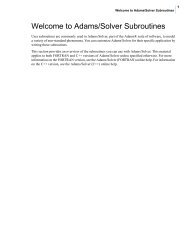You also want an ePaper? Increase the reach of your titles
YUMPU automatically turns print PDFs into web optimized ePapers that Google loves.
4.3.6 Simulation»Construct Entity (QUEST only)<br />
<strong>Virtual</strong> <strong>Machine</strong> Reference, Menu Bar<br />
Simulation»Construct Entity (Quest only)<br />
Provides the ability to add<br />
physical entities (i.e.,<br />
things you can see) to the<br />
model. This menu selection<br />
is only available in QUEST. The “<strong>Machine</strong>s” section must be opened before you can add<br />
entities to the model. The VM Construct tool bar provides buttons (as shown circled above) for<br />
each of the entities that can be constructed.<br />
All entities share some common parameters, listed below:<br />
� Name: Entity names are used in the Model Navigator in QUEST, and in collision diagnostic<br />
messages in CERUN and GENER. VM assigns default names when objects are created.<br />
You should change the default to something that is both short and meaningful.<br />
� Unit: Specifies the unit of measure for all non-rotary values (angles are always specified<br />
in degrees).<br />
� Position: Specifies the X, Y and Z axis position of the origin of the current object in relation<br />
to the origin and rotational alignment of the parent object. When world coordinates<br />
are selected (Simulation»Use World CS), the position of the entity is shown in world coordinates<br />
instead of relative to the parent object. When constructing an entity, the mouse<br />
pointer can be used to define the entity start position (and other parameters as well).<br />
� Collision detection: Select the Enable check box to activate collision testing against the<br />
current entity. A Safety zone amount can be specified when collision checking is enabled,<br />
which checks for a collision at the specified distance from the surface. You can see the<br />
extended collision envelope of all entities by toggling Simulation»Show»Safety Zones<br />
from the menu bar.<br />
� Spindle sweep: Select the “Do not generate sweep for spindle” check box to exclude the<br />
entity from spindle sweep volume calculations, which dynamically compute the swept<br />
volume of objects attached to a turning spindle for visualization and collision detection<br />
purposes. Excluding an object from spindle sweep calculations will reduce the CPU<br />
overhead of these calculations, but at the same time will omit the object for collision and<br />
visualization purposes while the spindle to which it is attached is turning.<br />
� OK button: Creates the entity as defined.<br />
� Cancel button: Ignores this entity creation request.<br />
� Apply button: Updates the simulation window to show the effects of the latest changes.<br />
� Rotate button: Use this button to rotate the entity to its required final orientation. When<br />
an entity is rotated, anything attached below this entity in the Navigator will be defined in<br />
the new frame of rotation.<br />
� Material button: Use this button to define the appearance (color) of the object. Material<br />
properties are described later under the topic “Materials Dialog”. Objects are by default<br />
created using the material of the last object created or selected using the Materials Dialog<br />
(Ctrl Alt M shortcut).<br />
<strong>ICAM</strong> Technologies Corporation – Proprietary 91















